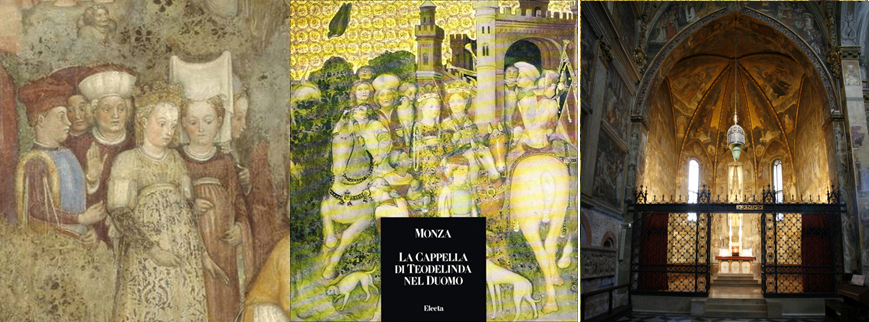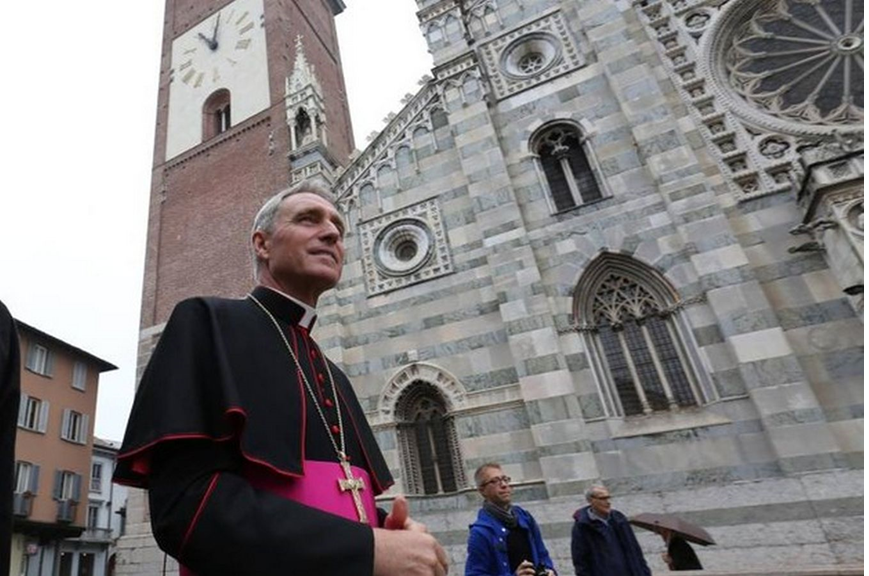 Benedict XVI and a historic Lombard queen
Benedict XVI and a historic Lombard queen
who was a Princess of Regensburg
by Sabrina Cottone
Translated from

October 24, 2016
Archbishop Georg Gaenswein has just become more acquainted with the figure of the Queen Theodolinda of the Lombards, who was Bavarian: portraits, stories about her life, relics like a fan, a comb, a cup, and objects like the vials in which she kept blessed oil brought from the Holy Land.
[The Lombards, also referred to as Longobards, were a Germanic people who ruled large parts of the Italian Peninsula from 568 to 774. They gave the name to the Italian region now known as Lombardy, of which Milan is the capital.]
The emeritus Pope's personal secretary since 2003, who is also his equerry, was in Monza for a historical lookback to the sixth and seventh centuries when the Lombard monarchs professed Arianism, and the role of Theodolinda, a Catholic princess from Regensburg who became queen and served as a bridge between Pope Gregory the Great and the royal court and the Lombard people, of whom she was a beloved queen.
[Pope Benedict XVI, in his two-part catechesis on Pope Gregory the Great in 2008, provides us with the proper context for appreciating Theodolinde and this current story about her:]
The Pope [Gregory the Great] - who was a true peacemaker - deeply committed himself to establish an effective peace in Rome and in Italy by undertaking intense negotiations with Agilulf, the Lombard King. This negotiation led to a period of truce that lasted for about three years (598-601), after which, in 603, it was possible to stipulate a more stable armistice.
This positive result was obtained also thanks to the parallel contacts that, meanwhile, the Pope undertook with Queen Theodolinde, a Bavarian princess who, unlike the leaders of other Germanic peoples, was Catholic, deeply Catholic.
A series of Letters of Pope Gregory to this Queen has been preserved in which he reveals his respect and friendship for her. Theodolinde, little by little was able to guide the King to Catholicism, thus preparing the way to peace.
The Pope also was careful to send her relics for the Basilica of St John the Baptist which she had had built in Monza, and did not fail to send his congratulations and precious gifts for the same Cathedral of Monza on the occasion of the birth and baptism of her son, Adaloald.
The series of events concerning this Queen constitutes a beautiful testimony to the importance of women in the history of the Church.
Gregory constantly focused on three basic objectives: to limit the Lombard expansion in Italy; to preserve Queen Theodolinde from the influence of schismatics and to strengthen the Catholic faith; and to mediate between the Lombards and the Byzantines in view of an accord that guaranteed peace in the peninsula and at the same time permitted the evangelisation of the Lombards themselves.
Therefore, in the complex situation his scope was constantly twofold: to promote understanding on the diplomatic-political level and to spread the proclamation of the true faith among the peoples.
 Mons. Gaenswein in front of the Cathedral of Monza.
Mons. Gaenswein in front of the Cathedral of Monza.
Gaenswein was in Monza, a city nine miles northeast of Milan, because Benedict XVI agreed that a book
La Cappella di Teodolinda nel Duomo di Monza. Atlante Iconografico (The chapel of Theodolinde in the Cathedral of Monza: An iconographic atlas), would be dedicated to him. The book is an
opera omnia about the chapel and the Corona Ferrea
['Iron Crown', with which the Kings of Italy and the Emperors of the Holy Roman Empire were crowned since the High Middle Ages to the 19th century. According to tradition, a nail from the Cross of Christ, brought back from the Holy Land by St. Helena, was used in making the crown, and so, it has always been venerated as a relic. In 1546, St. Carlos Borromeo instituted the Cult of the Holy Nail, making the crown officially a relic. The crown has been contested by kings, emperors and popes, but it has remained in Monza.]
Gaenswein said that the emeritus Pope continues to receive many requests for interviews or to write prefaces for books but has decided not to do these anymore. "This is about having this particular book dedicated to him, and that's different".
It was Gaenswein's first visit to Monza. With the images from the chapel fresh in his mind, he spoke to a group of journalists at the foot of a statue to St.John the Baptist which dominates the new section of the Cathedral Museum.
From Wikipedia, more about Theodelinde and Monza: Theodelinde, daughter of Garibald I of Bavaria and wife of the Lombard king Authari (and later of king Agilulf), chose Monza as her summer residence. Here in 595 she founded an oraculum dedicated to St. John the Baptist. According to the legend, Theodelinde, asleep while her husband was hunting, saw a dove in a dream that told her: modo (Latin for "here") indicating that she should build the oraculum in that place, and the queen answered etiam, meaning "yes". According to this legend, the medieval name of Monza, "Modoetia", is derived from these two words. She also had a palace (the future Royal palace) built here.
He remarked to the newsmen: "This little-known Princess of Regensburg, who became Queen of the Lombards, had no political formation at all, but she succeeded in her political activity because her compass was the faith. So she was able to pacify opposing and incompatible realities. This is a very important message".
Even for today? "Of course. She was not merely a messenger but a creator of peace. And she was a woman, the first woman to have done so [in Italian history], and she did this when she was little more than a girl."
During his visit, he said, what struck him most was how "faith is able to bring peace, to pacify realities that seemed impossible to pacify". A truth that has lasted, he says. "Even if the Corona Ferrea is based on a myth, it is nonetheless a unique symbol for the world, for having brought the effects of peace. Where there is peace, there is humanity; where there is none, there is a lack of humanity".
Benedict XVI, he noted, has always appreciated the contributions to the Church of feminine genius, and as Pope, he canonized and proclaimed the multifaceted and very complex Hildegarde von Bingen a Doctor of the Church.
"He had begun to study the figure of Theodolinde - although not as profoundly as he might have wished - because there is a link of the heart, from one Bavarian to another... She was from Regensburg, where Joseph Ratzinger was a professor, where he had a home to which he always returned for a month in August while he was Prefect of the CDF in Rome. But after he became pope, it has become a museum and research center".
Of course, Gaenswein - who has shared times of joy as well as difficult times with Benedict XVI - was asked how Papa Ratzinger is doing these days, when he is out of the public eye, despite the recent book-length interview with Peter Seewald.
"As you know", Gaenswein said, "the book was not intended at all, but Seewald came to visit Benedict XVI, before he announced his renunciation and after he retired, in order to gather more material for a new biography of the pope that he was writing. But at a certain point he realized that 'I have received some very beautiful answers, and it would be a pity not to publish them first'. He had to convince Benedict XVI to have the interviews published as a separate book. And the pope said, 'If Pope Francis agrees that it can be published, then I will yield'. And so it came about."
Gaenswein also addressed the problem of Benedict's eyesight.
He says in the book that in 1992-1993, he suffered from an embolism that destroyed part of one eye. But more than 20 years have passed, and he has not had further problems with it, and so no one else was even aware of it. When I presented the book in Munich and said this, the headline everywhere was that Benedict XVI is half-blind!
He is almost 90 years old, his mind is very clear, even if his legs increasingly cause him problems. He lives like a monk, he has not left the Vatican, and he has appeared in public only when Pope Francis asks him to. The last occasion was on June 28 for a modest ceremony to commemorate the 65th anniversary of his priesthood. You can see that he seems to become 'smaller'. But he continues to take active interest in the life of Italy and of Germany, and of course, of the Church.
Gaenswein, who is Prefect of the Pontifical Household and is among the principals involved in drawing up the pope's official schedule, was asked whether Pope Francis will come to Monza on March 25 when he makes a pastoral trip to Milan.
He said:"One day can be a lot or too little. The pope has a great desire to be seen by as many as possible. But preparations are still under way, and for now, I do not have an answer."
[Modificato da TERESA BENEDETTA 27/10/2016 01:45]